Related Research Articles

The Algerine-class minesweeper was a large group of minesweepers built for the Royal Navy (RN) and the Royal Canadian Navy (RCN) during the Second World War. 110 ships of the class were launched between 1942 and 1944.

HMS Algerine was a Phoenix-class steel screw sloop of the Royal Navy. She was launched at Devonport in 1895, saw action in China during the Boxer Rebellion, and later served on the Pacific Station. She was stripped of her crew at Esquimalt in 1914, and transferred to the Royal Canadian Navy in 1917, being commissioned as HMCS Algerine. She was sold as a salvage vessel in 1919 and wrecked in 1923.

HMS Hydra was a reciprocating engine-powered Algerine-class minesweeper built for the Royal Navy during the Second World War. She was badly damaged during the war and was scrapped in 1947.
HMCS Kapuskasing was an Algerine-class minesweeper that served in the Royal Canadian Navy during the Second World War. The vessel was primarily used as a convoy escort in the Battle of the Atlantic. Following the war she saw service as a hydrographic survey ship with the Department of Mines. She was named for Kapuskasing, Ontario.
HMCS Middlesex was a reciprocating engine-powered Algerine-class minesweeper built for the Royal Canadian Navy during the Second World War. Entering service in 1944, the vessel served as a convoy escort in the Battle of the Atlantic. Following the war, the ship ran aground on 2 December 1946 and broken up for scrap.

HMCS Fort Frances was an Algerine-class minesweeper that served in the Royal Canadian Navy during the Second World War. She served primarily as a coastal convoy escort in the Battle of the Atlantic. The ship was named for Fort Frances, a town in northwestern Ontario. Following the war, the vessel was transferred to the Department of Mines and Technical Surveys and used for hydrographic and oceanographic survey. The vessel was discarded in 1974 and broken up for scrap.
HMCS St. Boniface was a reciprocating engine-powered Algerine-class minesweeper built for the Royal Canadian Navy during the Second World War. During the war, the vessel was used as a convoy escort in the Battle of the Atlantic. Following the war, the ship was sold for civilian use as a merchant vessel, last being registered in 1954.
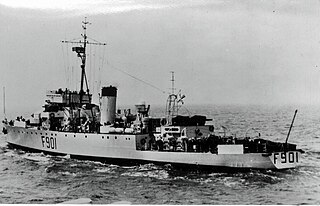
HMCS Wallaceburg was an Algerine-class minesweeper that served in the Royal Canadian Navy during the Second World War as a convoy escort during the Battle of the Atlantic. After the war the vessel was used from 1950 to 1959 for cadet training. In 1959 she was sold to the Belgian Navy and served until 1969 as Georges Lecointe, the second ship to be named after Georges Lecointe.

HMCS Winnipeg was an Algerine-class minesweeper that served in the Royal Canadian Navy during the Second World War. Used primarily as a convoy escort, the vessel served in the Battle of the Atlantic. Following the war she placed in reserve before being sold to Belgium and renamed A.F. Dufour. She served with the Belgian Navy until 1966.

The Battle off Cape Gata, which took place June 17, 1815, off the south-east coast of Spain, was the first battle of the Second Barbary War. A squadron of vessels, under the command of Stephen Decatur, Jr., met and engaged the flagship of the Algerine Navy, the frigate Meshuda under Admiral Hamidou. After a sharp action, Decatur's squadron was able to capture the Algerine frigate and win a decisive victory over the Algerines.
HMS Algerine was a Pigmy–class 10-gun schooner of the Royal Navy. She was launched in March 1810. She served in the North Sea and then transferred to the West Indies, where she was wrecked in 1813.
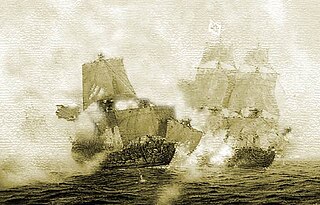
The action of 28 November 1751 was a naval engagement off Cape St. Vincent between a squadron of two Spanish ships of the line under captain Pedro Fitz-James Stuart and an Algerine squadron of two ships of the line under corsair Mohammed Chirif, which was fought from November 28 to December 2, 1751, and resulted in a victory for the Spanish fleet. The Algerine ships had come from the port of Algiers, and were acting as corsairs, conducting commerce raiding against Christian merchant ships and enslaving their crews. This was part of the Barbary slave trade, where the Barbary states, autonomous vassals of the Ottoman Empire, raided Christian settlements and merchant vessels for slaves to sell in their own cities. The corsairs targeted Spain, a Christian country, and the Spanish Navy was sent to track down the formidable Algerine force of two ships of the line, which posed a significant threat to any Christian vessels in the region. When the fleets sighted each other on November 28, 1751, they found that they were evenly matched with their opposition; both fielded two ships of the line.

The Bombardment of Algiers in August 1783 was a failed attempt by Spain to put an end to Algerine privateering against Spanish shipping. A Spanish fleet of 70, sailing under Rear Admiral Antonio Barceló, bombarded the city eight times between August 4–8 but inflicted only minor damages to the Algerine military. Both Spaniards and Algerines fought poorly, but Barceló, blaming unfavorable weather conditions, gave the order to withdraw. His expedition was judged a failure at the Spanish court, being described as a "festival of fireworks too costly and long for how little it entertained the Moors and how it was used by whomever paid for it".
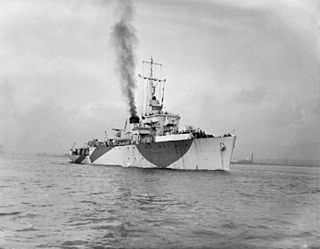
HMS Vestal was a turbine-powered Algerine-class minesweeper of the Royal Navy. She was launched in 1943 and saw service in the Pacific War against the Empire of Japan. She was critically damaged by Japanese kamikaze aircraft in 1945 and was subsequently scuttled in waters close to Thailand.

HMS Algerine was the lead ship of her namesake class of minesweepers built for the Royal Navy during World War II, the Algerine-class minesweepers. Initially assigned to the North Sea, she was transferred to lead the 12th Minesweeping Flotilla. The Flotilla were posted to the Mediterranean to assist with Operation Torch. In 1942, after a successful mine clearing operation off Bougie, she was torpedoed by the Italian submarine Ascianghi, causing Algerine to sink, leaving only eight survivors.
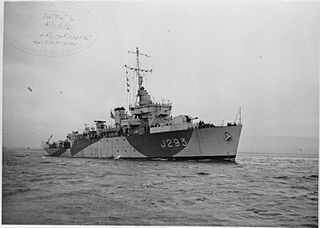
HMCyS Parakrama, was a turbine-powered Algerine-class minesweeper of the Royal Ceylon Navy, originally built as HMS Pickle (J293) for the Royal Navy during World War II, and transferred to Ceylon by the United Kingdom in 1958. She was scrapped in 1964.

HMS Hare (J389) was a turbine engine-powered Algerine-class minesweeper during the Second World War. She survived the war and was sold to Nigeria in 1958 as HMNS Nigeria.
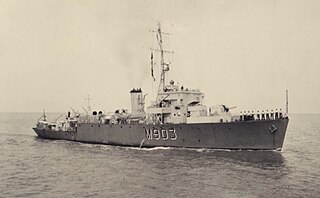
HMS Fancy (J308) was a turbine engine-powered Algerine-class minesweeper during the Second World War. She survived the war and was sold to Belgium in 1951 as A.F. Dufour (M903).

HMS Cockatrice (J229) was a reciprocating engine-powered Algerine-class minesweeper during the Second World War.
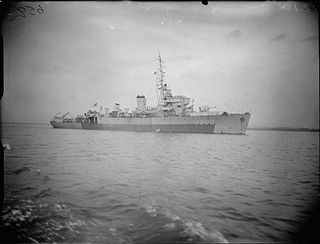
HMS Jewel (J390) was a turbine engine-powered Algerine-class minesweeper during the Second World War.
References
- ↑ Anderson, R. C. (1952). Naval Wars in the Levant 1559–1853. Princeton: Princeton University Press. p. 176. OCLC 1015099422.